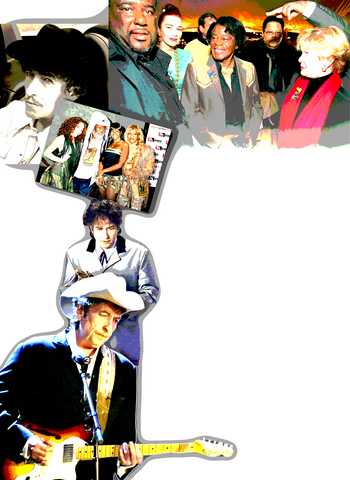Several weeks back, someone directed me to a Web site to see a clip of George Clinton and the Parliaments, in you-will-freak-out tones. I looked on the Internet at youtube.com and found my way to it. I was freaked out, though not just by the music.
There is Clinton, in 1969, on Say Brother, a tele-vision show, in Boston. (This is early Clinton, even before Funkadelic's first album -- the Parliaments would soon become Funkadelic.) He is wearing a purple jumpsuit with crossed suspenders over bare shoulders and a kind of rounded Mohawk, a shaved band of scalp below a bulbous crown of hair.
The band plays a series of vamps. The first builds on Sly and the Family Stone's Into My Own Thing. "What is soul?" Clinton yells, in the middle of the song. "What, brother?" responds the band's other lead singer, Fuzzy Haskins. "Soul is the hamhock in your cornflakes!" Clinton intones.

PHOTOS: AGNECIES
After a break, the Parliaments stretch out at length, playing their acid-Motown for almost 10 minutes, going from vamp to vamp; at a climax, Clinton rolls on the floor. The band becomes a mob of rising fists and shaking hips. The sequence ends with the guitarist Eddie Hazell detuning his strings and distributing a cloud of feedback, with various band members whacking cymbals.
I am not a collector of music, or of video. I have had friends play me the best clips from their music video collections, in full, collectorish, this-will-freak-you-out mode, and enjoyed it. Still, I don't really love music on video, per se. It reduces a performance so brutally.
But a missing link of performance history as potent as that George Clinton thing? Even if on bad video? It's hard not to keep looking. Over the last few weeks, I have been looking at YouTube until my head hurts.
New territory
Part of that headache comes from watching blurry images on a small screen. Part of it comes from annoyance at a lack of annotation: there's so little information given about what you're seeing. And part of it, I admit, is the worry that it all may soon disappear, or move to someplace on the Internet that will be harder to sniff out.
YouTube, based in San Mateo, California, is an amateur video-sharing site that had its official debut on Dec. 15, after a seven-month public development. It makes its money from text-only banner advertisements, running at the top and bottom of its Web page.
Like myspace.com, YouTube will serve as host to anyone's personal Web page, listing the subscriber's age, gender, relationship status, interests and so on. Much of its content is home videos, not just music, which subscribers upload from their digital cameras to their own individual YouTube sites. Among them are videos made by soldiers in Iraq war zones.
As you can imagine, some extremely bad amateur music-making has also been filmed, in peaceful territories. Anyone can watch a video on YouTube with a high-speed Internet connection. It couldn't be easier. The viewer streams the video, rather than downloading a file; it is not a peer-to-peer site, the kind that the US Supreme Court has gone after.
Assenting to YouTube's terms of use, a potential uploader must aver that he has the necessary licenses and permissions for each clip he uploads, including the consent of every person in the clip. The assurance of the uploader is all that's asked for, at least until a copyright holder with a potential copyright issue approaches the company. (YouTube has a staff of only 20, and the only censorship they have exercised thus far is of "inappropriate" material, meaning pornography.)
If the copyright holder of a video that has been bootlegged complains about an illegal upload on YouTube, said Chad Hurley, the company's chief executive, it will immediately shut down the link, thereby canceling anyone's ability to see it then and thereafter -- because nobody has downloaded it.
YouTube had 1 million visitors in November, and 3 million in December. Julie Supan, the company's marketing director, said YouTube is now up to more than 10 million videos viewed daily. "We're streaming 115 videos a second," she said, "6,944 per minute."
There are other such sites for home videographers, including Vimeo, Google and clips.tv. But if you type "Al Green" into video.google.com, you will access a man in his bathrobe singing along tunelessly to Let's Stay Together as a dubious present to his girlfriend. Type "Al Green" into YouTube, and you will find four appearances by the Reverend Al Green on Soul Train in the early 1970s, exercising his serene control over the audience. Likewise, type "Sarah Vaughan" into Vimeo: nothing. Type it into YouTube and you get Vaughan at the height of her powers in 1951 on television, singing You're Not the Kind.
But there is little information attached to the Vaughan clip, of the kind that an official release or a real audiovisual library would provide. Eric Kulberg of Universal Media, a small Washington-based company that researches and licenses music clips for television documentaries, said it comes from a 1950s television series called Showtime at the Apollo; that it was probably filmed at the Apollo Theater; and that the clip may have been shown on public television at some time in the last 25 years. He does not believe, he added, that it is commercially available.
The lack of information with these music clips is a logistical problem. There are also, obviously, legal and ethical problems with many of the clips on YouTube. David Peck of Reelin' In the Years Productions, which calls itself the largest library of music footage in the world, owns rights to some of the clips that have been uploaded to YouTube without proper rights clearance. Among these are clips of Howlin' Wolf performing at the American Folk Blues Festival in 1964, which have been commercially released on DVD.
Peck was aware of YouTube and said he had two reactions to the situation. "One is `You jerks, you have no right,"' he said. "We pay the Howlin' Wolf estate when we sell that DVD. The other is, `What can I do?' I'm not a big company. I have fought many big companies before who have used my footage and I've won every single time. I protect the rights. But there are so many bootleggers out there. I am not condoning this. But if it takes me US$5,000 in legal fees, I've blown my next couple of royalty checks."
Informed that YouTube was a company with employees, not just a fly-by-night Web site, Peck changed his tone. "That's a different story," he said. "That's very disturbing."
A spokesman for the Recording Industry Association of America maintained the organization's blanket position: that uploading or distributing copyrighted material, without permission from the copyright holder, is illegal.
Whitney Broussard, an entertainment lawyer specializing in music, says YouTube seems to be protected by a safe harbor in the Digital Millennium Copyright Act of 1998, which says that in such cases with streaming media, if the copyright holder protests and asks YouTube to shut down the link, and if the company promptly complies, then it is legally clear. (Supan of YouTube said the same thing.)
Of course, shutting down a particular link will not ensure that a bootlegged video will just go away. Andrew Solt of Sofa Productions, who holds copyright on the Ed Sullivan Show library, said he recently spent two days with a lawyer and two assistants preparing the necessary paperwork for YouTube to eliminate its links to uploaded bootleg Sullivan shows. YouTube complied. The next day, Solt said, they were all online again, presumably uploaded by someone else.
Battle lines emerge
YouTube's simplicity has been an attraction for bands, too. Plenty of them, or their record labels, have been uploading video footage to YouTube for promotional purposes, YouTube said -- they include current groups like We Are Scientists, Pretty Girls Make Graves, Early Man and Taking Back Sunday. (Even Nike has begun to use YouTube to its own ends, the Web site says, stealthily putting its products in sports video clips that don't look like ads.) The other day, a publicist for Sparks, an aging cult band with a new album, suggested that I go to YouTube to look at a 30-year-old clip of the group on television, which had not been uploaded by the band or its label.
In my own YouTube searches, first I went back in my past, curious to see again the things that I have been replaying in my head over the years from chance television encounters -- like Nat King Cole and Ella Fitzgerald on Cole's television show, or Public Image Ltd on Top of the Pops, or Black Sabbath in an early-1970s European concert.
But quickly I found my way to other things, which I had heard about but had filed into myth, films I thought I might never see: clips from the notorious, rarely shown Bob Dylan documentary Eat the Document; a staggering James Brown performance at a Boston concert in 1968; Hound Dog Taylor at a mid-1960s blues festival; Black Flag throwing down at a club in 1984, when Henry Rollins was a big weakling. Brazilian music fans have begun to upload their collections, and they have their work cut out for them: the history of Brazilian popular music over the last 50 years has been closely intertwined with television. There is very little jazz as yet.
It's stupefying to know what's out there. Perhaps its shady proliferation will hasten official, high-quality versions, videos that do not provoke headaches and could properly expand everybody's understanding of history's greatest performing artists.
"I don't think there would be a market for all this stuff on YouTube," Peck said, "if everyone -- artists, labels, publishers and rights holders -- could get together and find reasonable ways to release it."

In recent weeks the Trump Administration has been demanding that Taiwan transfer half of its chip manufacturing to the US. In an interview with NewsNation, US Secretary of Commerce Howard Lutnick said that the US would need 50 percent of domestic chip production to protect Taiwan. He stated, discussing Taiwan’s chip production: “My argument to them was, well, if you have 95 percent, how am I gonna get it to protect you? You’re going to put it on a plane? You’re going to put it on a boat?” The stench of the Trump Administration’s mafia-style notions of “protection” was strong

Every now and then, it’s nice to just point somewhere on a map and head out with no plan. In Taiwan, where convenience reigns, food options are plentiful and people are generally friendly and helpful, this type of trip is that much easier to pull off. One day last November, a spur-of-the-moment day hike in the hills of Chiayi County turned into a surprisingly memorable experience that impressed on me once again how fortunate we all are to call this island home. The scenery I walked through that day — a mix of forest and farms reaching up into the clouds

Late last month US authorities used allegations of forced labor at bicycle manufacturer Giant Group (巨大集團) to block imports from the firm. CNN reported: “Giant, the world’s largest bike manufacturer, on Thursday warned of delays to shipments to the United States after American customs officials announced a surprise ban on imports over unspecified forced labor accusations.” The order to stop shipments, from the US Customs and Border Protection (CBP), came as a surprise to Giant, company officials said. Giant spokesman Ken Li (李書耕) said that the CPB never visited the company’s factories to conduct on-site investigations, nor to interview or

“Eighteen years ago, people didn’t even know the name of this ingredient,” says 58-year-old Gil Sa-hyeon, holding up a cluster of dried brownish stems. “Now it’s everywhere.” His shop, Joseon Yakcho, sits in the heart of Seoul’s Yangnyeongsi Market, South Korea’s largest traditional medicinal herb market, its streets lined with shops displaying buckets of herbs such as licorice root and cinnamon bark that spill on to the pavements, filling the air with their distinct, earthy aroma. The ingredient Gil is referring to is hovenia dulcis, known in Korean as heotgae — the oriental raisin tree that’s become the cornerstone of South Korea’s